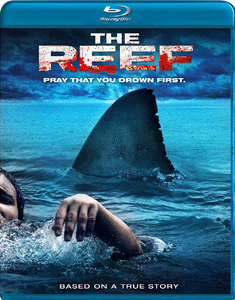“Jaws” (1975) was a famously expensive and physically punishing production, mostly because it used a mechanical shark. But the film was intense, and a classic, and it launched Steven Spielberg’s career and blockbuster culture. So it was worth the blood, sweat and tears. “The Reef” (2011) is decidedly cheaper – I’m confident there isn’t a fully built fake shark in the picture, and no more than one CGI shot – yet it’s equally intense.
“The Reef” — which will get a sequel on July 29 (“The Reef: Stalked”) — comes from Australian writer-director Andrew Traucki, who specializes in showing the thin line between civilization and brutal nature. He also did a couple of “Black Water” crocodile pictures.
Masterful editing
At least on this film, he also specializes in being efficient. “The Reef” uses footage of real great white sharks, which I assume is far less expensive to acquire than believable special effects shots. This footage combines with Luke (Damian Walshe-Howling) peering into the murk, eyes wide behind his goggles, to create a reality that’s not only plausible, but nail-biting.

“The Reef” (2011)
Director: Andrew Traucki
Writer: Andrew Traucki
Stars: Damian Walshe-Howling, Zoe Naylor, Adrienne Pickering
On Tuesdays this summer, Reviews from My Couch is highlighting classic (and not so classic) shark horror films through the years.
The subtle bass score by Rafael May is exquisite. The editing by Peter Crombie masterfully blends shark footage with the actors playing terrified as their characters expend more blood, sweat and tears than Spielberg on “Jaws.” They sputter and blubber in raw fear, and even though Luke has said silence and stillness is important, we can’t blame them.
Luke is joined on a yacht jaunt from the Australian coast to an island by hot-and-cold love interest Kate (Zoe Naylor), Kate’s brother Matt (Gyton Grantley), Matt’s wife Suzie (Adrienne Pickering), and Luke’s fisherman colleague Warren (Kieran Darcy-Smith).
They are normal people without sweeping cinematic problems. Kate is a little hesitant to dive into a relationship, that’s all. I like that these are grown-ass men and women in their 30s and 40s. They aren’t impulsive teens.
Yes, they make planning mistakes that contribute to their predicament. But mainly they have horrible luck of hitting coral and capsizing. Then they have to swim to the nearest land, since the current is taking the overturned yacht farther out to sea.
Swimming with sharks
Traucki masters the style of horror where “what you don’t see is scary.” “The Blair Witch Project” was famously credited with achieving this, but I prefer seeing something in the back half of horror films. “The Reef” delivers in a big way after a first half filled with the swimmers nervously asking “Did you see that?!”

Granted, I spotted the money-saving moves. Except for one instance, we don’t crisply see a shark attack; the violence is often shot from a distance, as if respectfully (but still brutally). We don’t see the boat hit the coral; we see Luke experiencing it (which is effective).
Some viewers might not appreciate that a couple plot points are wrapped up in a closing scrawl, rather than by filmed scenes.
But when that first attack occurs, it’s harrowing enough to keep you up at night. After that, I’m sure I looked like the nervous Kermit the Frog giphy through the end of the film. There isn’t much relief in “The Reef,” but it is only 94 minutes, so a viewer can see the finish line even if the swimmers can’t.
The film isn’t as fatalistic as “Open Water,” but it’s closer to that controversially bleak film than to “Jaws,” which allows a viewer the “relief” of action sequences, one-liners and compelling monologs. “The Reef” is all tension, inexpensively constructed, but without coming off as cheap.

